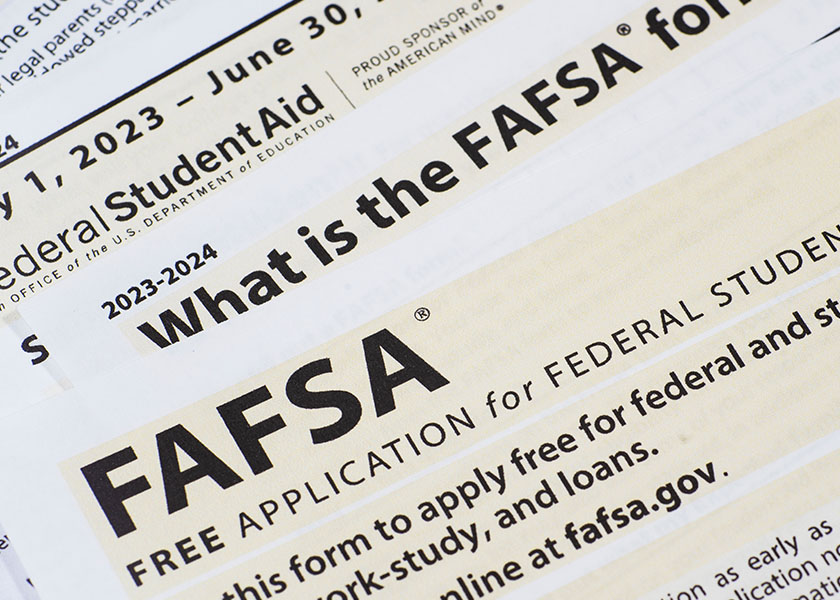By Ryan Egolf, EA, Senior Tax Planner
If you or your children are in the college hunt, the prospect of paying for school could be disheartening given its alarming price tag. The Education Data Initiative estimates the average annual cost of public college in the United States to be more than $36,000 per student, rising to more than $55,000 for private universities. These figures include tuition, books, supplies, and dormitory expenses and do not factor in out-of-state tuition.
Fortunately, many families can apply for student aid to help cover these costs. The first step in accessing this funding is filling out the Free Application for Federal Student Aid (FAFSA) which opens the door to aid from federal sources, including Pell Grants and federal student loans. In many cases, colleges will also rely on the FAFSA to determine their institutional financial aid awards.
While filling out another financial form sounds about as appealing as writing yet another college essay, the good news is that a completely redesigned and simplified FAFSA has just been unveiled for the 2024–25 academic year.
The streamlined FAFSA shaves off scores of questions, reducing it from more than 100 questions to as few as 18 questions for some applicants, according to the Department of Education.
But its pared-back length is not the only distinctive feature. Here are eight other noteworthy changes families should be aware of.
1. You’ll have less time to complete the form.
While the FAFSA is traditionally released in October, the redesign pushed it to late December, effectively shortening the timeline by approximately three months. It’s important to fill out the form as soon as you can since some aid is first come, first served. The delay may also mean you have less time to compare offers from the different institutions because the FAFSA is the foundation on which most colleges build their individual financial aid offers, subsequently pushing back their process.
This reduced timeline only applies to this year. Come October of 2024, the FAFSA for the 2025–26 year should be back to its fall release. The filing deadline for the 2024-2025 FAFSA is June 30th, 2024 and will continue to be June in subsequent years. Any corrections to the form must be submitted by September 14th, 2024.
*Please note the 2024-2025 FAFSA is used for students attending colleges between July 1st, 2024 – June 30th, 2025.
2. The Expected Family Contribution (EFC) term has gone away.
The term EFC has been replaced with the Student Aid Index, (SAI). While both essentially measure the same thing — the amount of money the federal government believes your family can afford to pay for college — the SAI will present it differently, in a range from -$1,500 to $999,999. Ideally this new term will eliminate a lot of the confusion inspired by the EFC, which led many families to assume that was the exact amount they would be paying for school or receiving in aid. That number was usually adjusted up or down based on the individual school applied to and a variety of other factors.
3. In a single-parent household, the custodial parent must complete the FAFSA.
Previously, parents who were divorced or separated could choose which parent filled out the FAFSA. Now it must be the parent with whom the child lives for the majority of the 12-month period ending on the day the FAFSA is filed. For example, if the FAFSA is filed on January 1, 2024, the 12-month period would have started on January 1, 2023. It won’t consider the other parent’s income or assets as part of the financial aid calculation. In some cases, if the custodial parent is the low earner and has less assets, it can be advantageous for the child’s aid package.
4. The poverty line is higher for single parents.
One of the goals of the new FAFSA was to give more aid to single-parent households, and a key factor is a parent’s adjusted gross income (AGI). A student will qualify for the maximum Pell Grant amount if a single parent’s AGI is less than or equal to 225% of the poverty line, while it’s only 175% of the poverty line for two-parent households. (You can find out more about Pell Grant particulars here.)
5. Larger families may qualify for less aid than before.
With the previous calculation, families with more than one child in college often qualified for a larger aid package because the calculation considered cash flow rather than overall family wealth. However, with the FAFSA overhaul, this so-called “sibling discount” has been eliminated. Families with multiple children enrolled may receive less aid, which is important for families with twins or close-in-age siblings to note.
6. Small business owners could see a decrease in aid.
While the previous formula only considered businesses with more than 100 full-time employees, now all business owners must indicate the equity of their businesses. Proportionally impacting small businesses. That could lead to less aid if your business has a high valuation.
7. The “income protection allowance” will be raised.
The FAFSA “income protection allowance” is an amount of income designated for general living expenses, and thus omitted from the financial aid calculation. Currently set at $19,080 for a two-parent family with one dependent, it will rise to $23,330. The dependent student protection allowance — the amount a student can earn without impacting their financial aid eligibility — will also increase, from $7,040 to $9,410.
8. No aid consequences for contributions from individuals other than parents.
Previously, the FAFSA families were required to report other funds received or paid on the student’s behalf for college. For example, if a family’s grandparents paid $10,000 of tuition from a 529 account, that would have been considered untaxed income for the student and would have negatively impacted their EFC. But starting with the 2024–25 school year, these conditions will not impact the student’s SAI.
However, one thing won’t change … everyone should fill out the form.
Many families resist the FAFSA because they believe there won’t be a benefit or that they are obligated to pay for the child’s debt. Filling out the form is a doorway to funding avenues that may be available if you choose to access them and could unlock a sum of money you weren’t expecting. We highly encourage you to fill out the form as early as possible to ensure you have plenty of time to assess your options.
Find out more about the new FAFSA here, and to discuss saving and paying for college as part of your overall financial strategy, schedule a consultation with one of our financial advisors today.
Ryan Egolf is a Non registered representative of Cetera advisor Networks LLC.
For a comprehensive review of your personal situation, always consult with a tax or legal advisor. Neither Cetera Advisor Networks LLC nor any of its representatives may give legal or tax advice.
This blog is not intended to provide specific legal, tax, or other professional advice. For a comprehensive review of your personal situation, always consult with a tax or legal advisor. Investors should also consider whether the investor’s or beneficiary’s home state offers any state tax or other benefits available only from that state’s 529 plan. Any state-based benefit should be one of many appropriately weighted factors in making an investments decision. The investor should consult their financial or tax advisor before investment in any state’s 529 plan.


